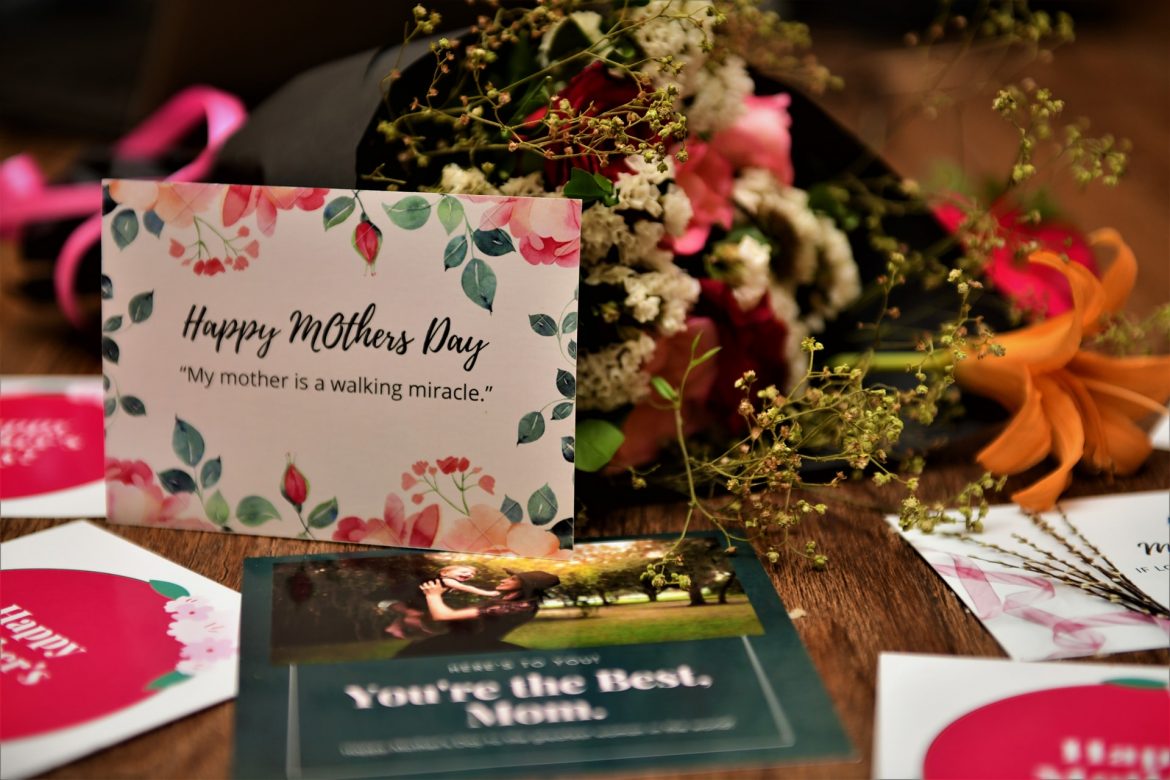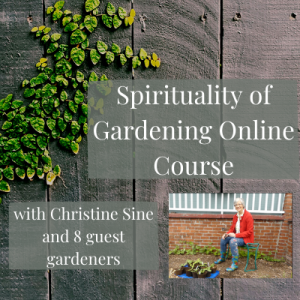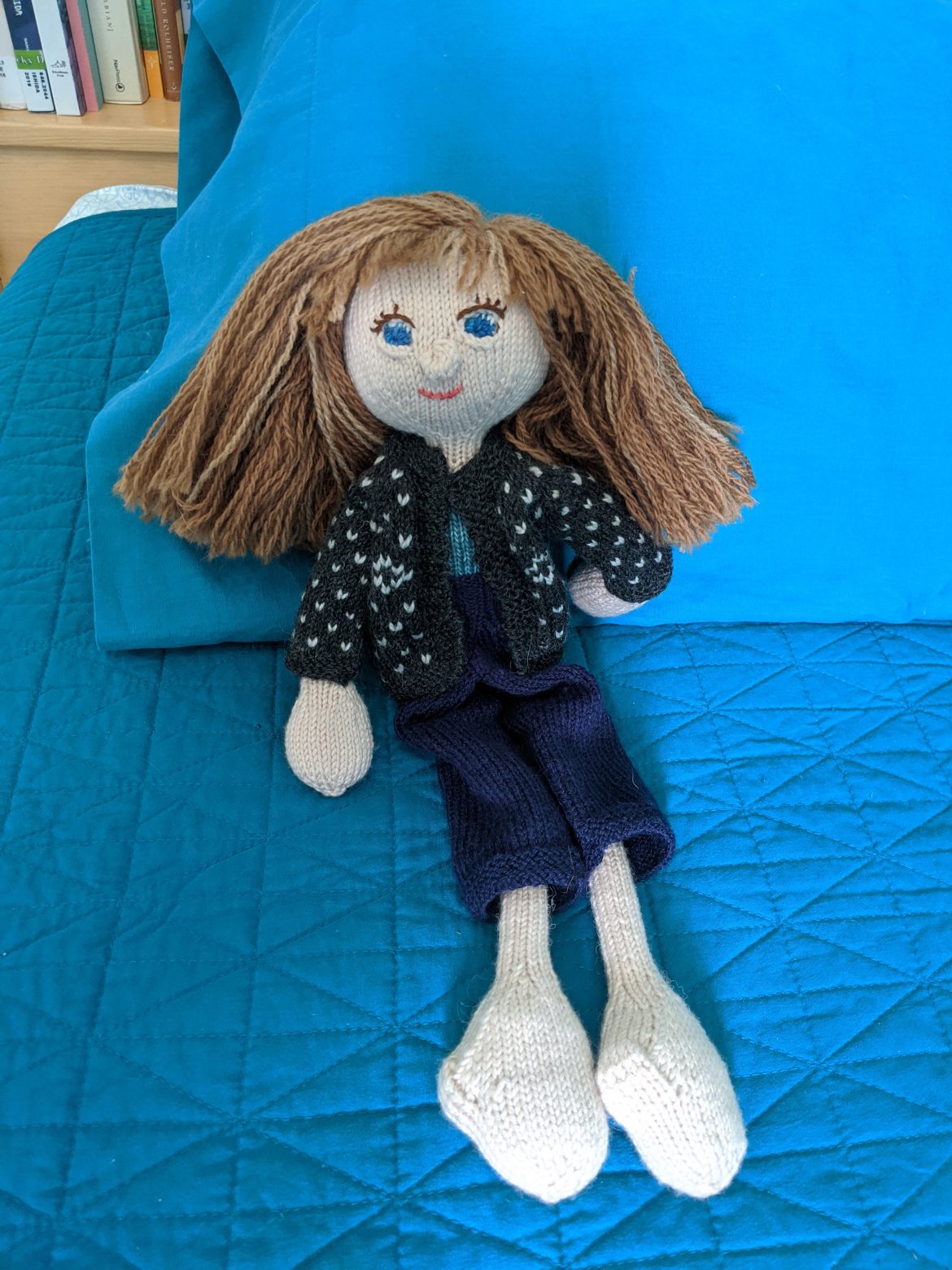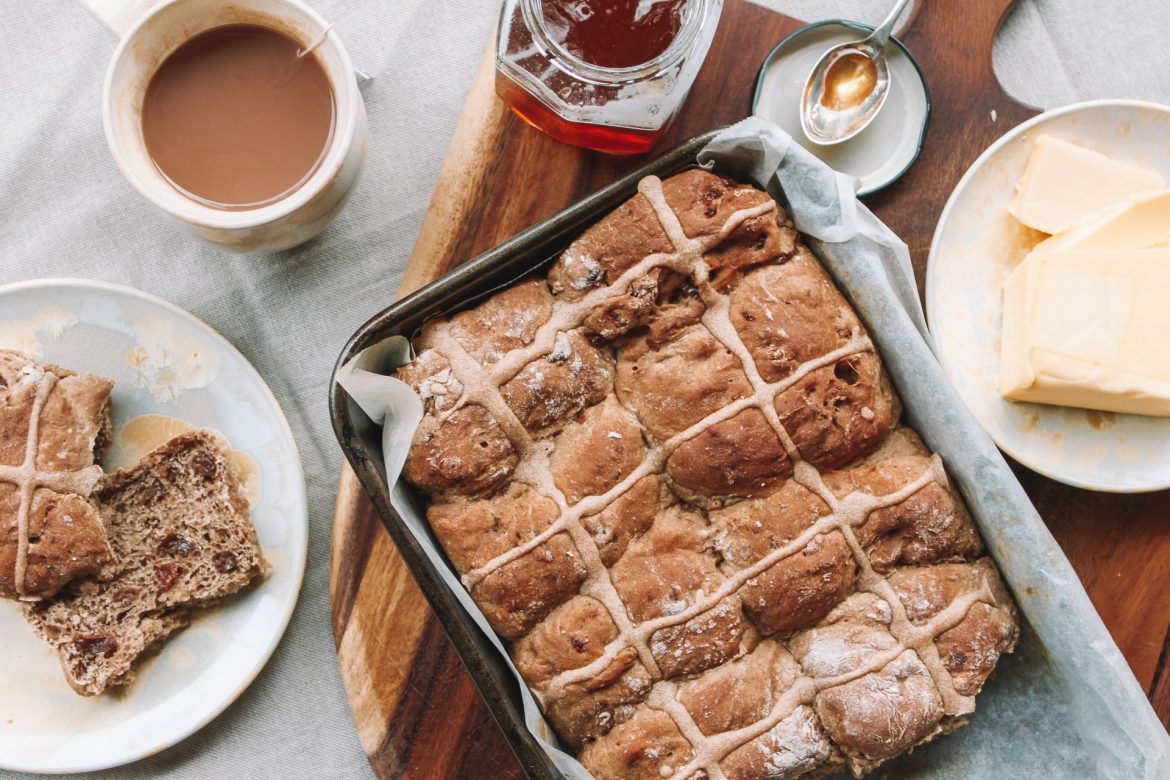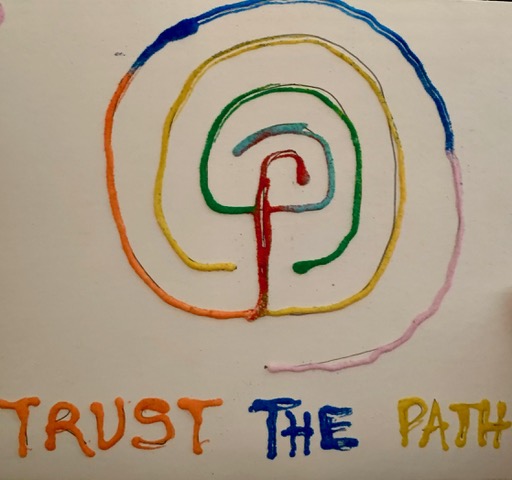A contemplative service with music in the spirit of Taize. Carrie Grace Littauer, prayer leader, with music by Kester Limner and Andy Myers.
Permission to podcast/stream the music in this service obtained from One License with license #A-710-756 with additional notes below:
“In Silence We Wait” Text and Music by Susan Masters. Copyright and all rights reserved by Augsburg Fortress Press
“Maker Song” Music and lyrics by Kester Limner, 2019. Shared under the Creative Commons License, Attribution (CC-BY)
“In God Alone my Soul (Mon Ame se Repose)” By J. Berthier — copyright 1991, all rights reserved by GIA/Les Presses de Taizé
“Shepherd Song” Words adapted from John 10:11-18. Music by Kester Limner. Creative Commons copyright–free to use with attribution (CC-BY)
Thank you for praying with us!
by Melissa Taft
Tomorrow heralds Mother’s Day in the US; it’s not too late to find a way to honor your mother or another mother in your life! The second Sunday in May is a popular time around the world to hold a celebration honoring mothers, including Canada, Australia, New Zealand, and many others – though it is certainly celebrated at other times in other countries. You’ve still got time, France!
You can find resources on Mother’s Day in our Seasons and Blessings Page, but I thought I’d offer a gathering of resources today for those who are still looking for encouragement or perhaps a prayer.
As we are still in the Easter Season, finding a way to honor a special mother in your life is a way to practice resurrection. Living into that joy and channeling it into celebrating your mother or another special mother is a fun spiritual practice. Whether you are planning a service for mothers or seeking to honor a mother individually, you might enjoy using this Mother’s Day Litany.
Perhaps you are a mother. Indeed, all of us are called in some way or another to mother, as we reflect the Image of God. You may wish to honor that mothering part of yourself by honoring God our Mother. Or you may wish simply to honor God in this way. This post on Maternal Images of God, as well as this post on Biblical Maternal Images of God, contains lovely reflections and images to center this idea.
In fact, if you find Mother’s Day difficult due to wounds in that area, it can be very healing to connect to God in this way. This Meditation Monday post on Connecting to the Mother Heart of God has a lovely prayer and meditation on this subject. There are many reasons why one might find Mother’s Day difficult, from child loss or infertility or adoption wounds to the loss of your mother, or many other circumstances. This reflection from Lynn Baab on difficulties surrounding Mother’s Day might be balm for your soul. This post on honoring birth mothers, and this post on mothering children with special needs, may also give encouragement to you – even if that isn’t your circumstance.
Motherhood isn’t easy; take time to reflect and care for yourself as well as a mother. This lovely poem from Kara Root and this reflection by Sara Easterly I found particularly meaningful for my own motherhood journey this year. My first Mother’s Day away from both my mom and my children, and I confess it has been a blessing to reflect even in the midst of sorrow at the separation.
Still there is joy to be found, even in my less-than-ideal circumstance, and even in yours. May God bless all the mothers on this Mother’s Day!
Photo by Ijaz Rafi on Unsplash
~ Goodfellow
Explore the wonderful ways that God and God’s story are revealed through the rhythms of planting, growing, and harvesting. Spiritual insights, practical advice for organic backyard gardeners, and time for reflection will enrich and deepen faith–sign up for 180 days of access to work at your own pace and get ready for your gardening season.
Lisa Scandrette is writing freerangefriday this week while I am out of town. I’ve known Lisa for almost twenty years and she is a dear friend! She lives out her faith daily through hospitality, creativity and compassion for others. She is a weaver, an educator and a world traveler! She also is amazing fiber artist!
“You knit me together in my mother’s womb…I praise you because I am fearfully and wonderfully made.”
It has been easier for me to quote this verse than to embed the belief into my own heart. In 2020, seeking to live into this truth, I decided to knit a doll of myself in order to meditate on this truth. I selected a pattern, yarn for her flesh, hair, eyes, and clothes, and began to slowly knit my doll-formed self. As I knit her, I reflected on how I embrace who I am made to be.
When I knit, it takes lots of care and intention. It starts with selecting the yarn. What is most suitable for the project I am making? Then comes a knit sample to make sure that the item I am knitting with turn out the size that I am anticipating when I am done. And then I cast on the project. The item is completed by creating loop after loop, stitch after stitch, one at a time. Rows build upon rows. The yarn passes through my fingers and I feel every inch of it. If I make a mistake, I carefully undo the previous stitches to fix the hole I have created. Knitting isn’t a slapdash way to create, but rather slow, thoughtful and precise. Each creation is unique. To suggest that God knit me together in my mother’s womb suggests that he took time, careful thought and planning to create me. Perhaps God started in one direction, thought better of it, and decided to make me different. Perhaps, like me, God sat back and examined her work, running her hands over it with thoughtful satisfaction, pausing to take it in from time to time.
My quirks, the way I’m wired—it’s all on purpose. Can I learn to love my quirks and imperfections? What about my gray streaks? What about the slow way I move in the world? Do I have the courage to embrace who I am and openly offer what I have, trusting that it will be used by God? Will I show up as my true self?
I struggle to honor my own voice, thoughts, and desires, tempted to believe that somehow mine are not as important or worthy as those of others. Or I believe the lie that what I have to offer doesn’t really matter. There are already so many competent voices speaking loudly. So, I am prone to self-censor and withdraw when I forget my true identity. Sometimes I think that mattering has to do with how many people hear me—the size of my “platform” or how many followers I have. But, I am not a big platform kind of person. I love the small and the beautiful. Deep down, I think the invisible and less visible matters. On a good day, I want to live beautifully and matter to the people that I know and love and come into contact with. On a good day, I want to love well in secret. But, there are other days that I feel the pressure that what matters must be public and loud. And I feel ill-equipped for that.
When I fall into the trap of comparison, I often think it would be better if I was more like another person—more eloquent, more put together in my appearance, more fit-looking, more activist, whatever the comparison of the day is. Instead, I am wanting to learn to become more fully the self I was created to be in all my quirky uniqueness.
As I’ve been working through these aspects of identity, my goal is to learn to become the most flourishing “Lisa” that God envisioned when I was knit together in my mother’s womb. In that light, I matter a great deal and what I say and do matters. If I lived more fully into this, I would care well for my physical needs. I would recognize and honor the gifts that I bring to the world and develop them. I would authentically own my thoughts and opinions, even when others disagree. I would write and let others see it, even if it’s just a few. I would express my creativity. I would surround myself with beauty. I would be comfortable in my own skin and honor what I already do to live in beauty and walk with Jesus, not just see the ways that I wish I did. I would be comfortable with my limitations, and I would step into things that I desire, but that I am not yet comfortable with. I would learn to not be limited by fear of mistakes or failure—in fact, I would embrace them as ways to learn. I would be secure in the fact that I am deeply beloved, no matter what I do, say or am.
My doll now sits among my books on a shelf in my office. She looks out with her blue eyes, wearing a Norwegian sweater just like mine. She makes me smile. I see the potential to add to her, to complete her representation even more. I am reminded that creating beauty takes time and I pray for God’s slow handiwork to be continually embodied in me.
God has knit you and I both together with care and intention. You matter! You are welcomed with joy, with eagerness, with open arms! You are celebrated and anticipated. How would you live if you embraced the person that God knit together so carefully in your mother’s womb? What would that look like for you?
Lisa Scandrette has devoted herself to a life of care, hospitality, and teaching. She regularly facilitates workshops and provides administrative support for ReIMAGINE, a center for integral Christian practice with a mission to help people become more fully human through engagement with the life and teachings of Jesus. She makes a life in the Mission District of San Francisco with her husband Mark and their three children, and she is coauthor of FREE: Spending Your Time and Money on What Matters Most.
Read about Lisa’s work with ReIMAGINE.
 It’s here! Christine Sine’s new book is now ready for purchase! Journey along with Christine as she walks you through contemplative container gardening. Reviews are coming in:
It’s here! Christine Sine’s new book is now ready for purchase! Journey along with Christine as she walks you through contemplative container gardening. Reviews are coming in:
“Digging Deeper is a beautiful companion for anyone who is looking for a mindful and sacred way of connecting their bodies to their souls, and their prayers to actions. All you need is a bowl, some dirt, this lovely book, and the desire to slow down and dig deep. – Jerusalem Jackson Greer, author of At Home in this Life: Finding Peace at the Crossroads of Unraveled Dreams and Beautiful Surprises”
guest post by Gary Heard
It’s a nuisance when Easter eggs appear as temperatures reach the 30Cs – having to consume all the chocolate before it melts! ‘Tis a sad waste of a wonderful delicacy to wash it away with soap… Yet this is a minor inconvenience when celebrating Easter away from the emerging spring, so woven into the traditional celebration of Easter inherited from our northern cousins. As Hedley Beare expressed recently (Faith 23/2), fourth-century Christians found it uncannily expedient to attach celebrations of the death and resurrection of Jesus to an earlier pagan festival marking the commencement of spring: themes of new life, rebirth and renewal already irresistibly embodied in the festival, waiting to be impregnated with Christian meaning. The emergence of new life in creation as trees and plants begin regeneration and new growth was a powerful symbol to reflect upon in light of the death and resurrection of Jesus Christ.
But does springtime fully embody the meaning of events surrounding the passion of Jesus? Are we in the Antipodes somehow deprived of a full appreciation of the Easter miracle? Or does this almost exclusive focus on new life mask something more profound about the life and teaching of Jesus?
In Australia Easter comes as trees shed their leaves, and fading light yields to increased darkness. The autumnal equinox marks the shift from days where light is the greater part of the day. Daylight saving’s end creates the impression of a sudden darkness as evening abruptly falls much earlier. The next three months brings days shorter, colder, somehow more alienating. We witness creation in throes of deconstruction: animals begin to hibernate, some birds spread their wings for warmer climes, many flowering plants shut down production, and deciduous trees shed their leaves, ultimately lending a more sober and subdued, even dreary hue to the landscape. While we feel some relief at the passing of scorching heat (although less so this year), there appears little to celebrate, little sign of the new life integral to the Easter story.
The Australian context has yet to find its expression in this Christian celebration. Alongside borrowed Christmas symbols of snow and holly, our Easter celebration strikes a discordant note with the landscape, creation somehow out of sync with the Creator. Either we need to move the celebration of Easter to a more appropriate time of year, or seek themes and messages more consistent with creation’s voice. If an authentic and relevant spirituality reflects and shapes the rhythms of life, how can we ground the Christian message in experiences and symbols common to our setting, as it seems to have been practised by the early church? Is this possible with Easter?
My discomfort with the way Easter – particularly Good Friday – is celebrated in many churches extends beyond its dissonance with the surrounding landscape. Easter within the church reflects society’s broader reluctance to grapple with any sense of pain and loss. Rarely have I sat in a Good Friday service without hearing a strong proclamation of the resurrection: a thought not echoed in the experience of Jesus’ disciples, who were enveloped in despair as they watched Jesus die, the shadow deepened by their complicity in his death through either denial or abandonment in his time of need. In Jesus’ death they saw their hope die. The dream Jesus instilled in them dissipated at the cross.
Yet rarely have I experienced this in a Good Friday service. Jesus’ death seems trivialised against the backdrop of the resurrection, the disciples’ struggle and pain is glossed over, their sense of loss dismissed. Standing on this side of the resurrection makes it difficult to appreciate the emptiness they felt, yet in the journey of faith we must endeavour to enter that same space today.
Contemporary celebrations of Easter often overlook how this new life emerged. An all-pervading gloom marks the Easter story, as critical events occurred under cover of darkness: Jesus’ betrayal, arrest and trial, Peter’s denial; even Jesus’ death took place in darkness. The resurrection hope only emerged through the despairing death of Jesus – the one Christians call the Son of God. Jesus’ disciples, Jews, and Roman authorities clearly could not reconcile the two, as Jesus’ death appeared as conclusive evidence against his claims.
When our primary focus falls on the resurrection without contemplating the circumstances that made it necessary, we merely echo a motivational message that failure is not the end, merely an opportunity to learn and grow. Easter is no tale of persistence through tragedy. But for God raising Jesus from the dead, Jesus’ death was the end. The resurrection was the sole source of light in an otherwise dark tale, and yet an overwhelming source of hope. Jesus’ death flowed from his submission to God’s purposes. In an act of obedience and surrender, Jesus embodied his teaching that the way to life was to lose it, surrendering to the purposes of God. Not seeking to preserve his own life for his own sake, Jesus gave it up for a greater purpose.
Creation at autumn echoes that truth, as flora and fauna ‘die off’ for months, a necessary prelude to new spring growth. Symbols of death surround us: autumn leaves dancing their finale across the streets; lengthening sunsets and cooler evenings driving us into shelter earlier, just as much of the animal world retreats to cosier places; the cries of summer birds slowly silenced; creation slows its pace. As winter dawns, and winter blues cast their shadow, we may despair of ever experiencing summer sun once more. Yet this is part of creation’s rhythm, clearing away the old in preparation for the new. Only as these sights and sounds die can they be born afresh.
New life – springtime – stands now only as promise, just as resurrection was Jesus’ promise to the disciples, just as new life is promise to all who would follow Jesus. Born out of death, resurrected from the demise of the present, new life comes. It is a way to life few choose, preferring to trust in their own strength than to surrender into the hands of another, to hold on rather than let go. To truly live, we must be prepared to die.
Gary Heard is a Baptist Minister and senior lecturer in Pastoral and Ministry Studies in the University of Divinity. He is married to Evelyn and has three adult children.
Photo by Maddi Bazzocco on Unsplash
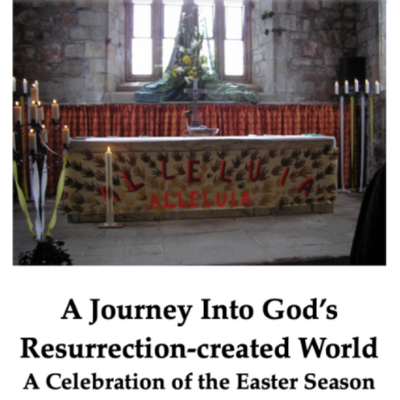 It is the Easter Season! Lasting from Easter into Pentecost, it is a time to celebrate and heal! This free download will help you find the joy in the season and includes practical suggestions for celebrating in a Covid-19 world as well.
It is the Easter Season! Lasting from Easter into Pentecost, it is a time to celebrate and heal! This free download will help you find the joy in the season and includes practical suggestions for celebrating in a Covid-19 world as well.
The Earth’s elements and seasons are among my favorite spiritual guides. My prayer life, my relationships with friends and family, the rich traditions of both the Church and culture(s) also offer me guidance. Yet, recently, sacred signs of Earth and Spirit are inviting me to discover my own rhythm of how to live authentically.
It is early spring in the Pacific Northwest. Where I live, winter and spring often overlap. On one day we can have both seasons; donning wool hats and gloves, shorts and sandals. In early spring the landscapes, particularly on the beaches, are chaotic. High winds and king tides cause havoc washing out footbridges and hiding trails with logs washing ashore.
Forests and gardens are also not quite the same place as they were previously. The land is no longer covered with winter’s comforting cold. Frozen ground is now muddy. The plants are gray and brown and to my eye do not look hopeful at all. Early spring seems to last forever. Winter is not finished and the greening power of God has not yet begun.
For me, the spiritual guidance of spring is an invitation to practice patience and to trust the Creator and the natural cycles of the Earth. I learn that nature is in charge and that she does not operate on the same schedule as our human-made calendars. Spring teaches me to surrender and accept “what is.” And “what is” is constant change and transition. Everything is pending and nothing is resolved. I confess that I find that challenging!
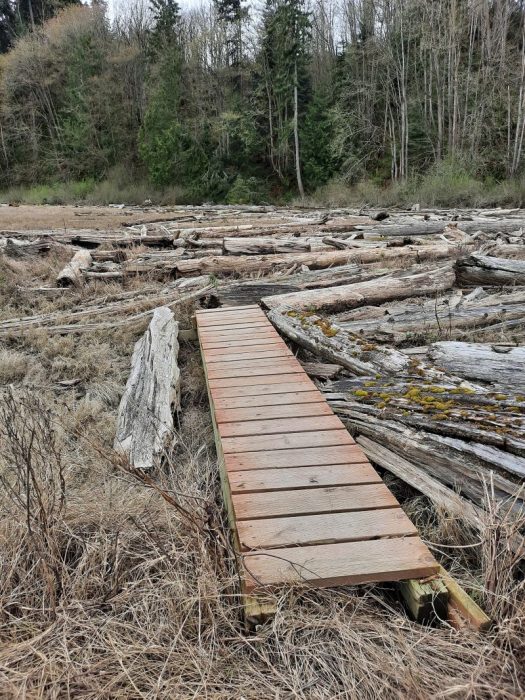
Early spring coincides with Lent. For me, Lent is the season to nourish my heart, the ground of my being. This year I had a daily ritual of looking for something beautiful every day; writing it in a beauty journal. Beauty was discovered in surprising and varied places. Some were in nature, but I also found beauty in my prayer, books, as well as in my personal relationships. This practice helped to counter my impatience with dark days, enabling me to live in the present moment. I cherish my journal with its list of forty days of beauty that I continue to appreciate.
Health challenges were part of my Lenten journey this year. A terrible chest cold kept me away from corporate worship and visiting grandchildren for over two weeks. Despite my beauty list there was one day in particular when I found myself slipping into self-pity and depression. I prayed and hit a wall of silence.
The sun was out and beckoned me to come outdoors. The wind was wild so I wrapped myself in a blanket and sat in a chair on my deck and tried praying again. I asked the Holy Spirit, who rides on the breath of the wind, to sweep me out and cleanse my body, mind and heart. I addressed Brother Wind and asked for his wisdom and guidance. I was presented with healing images of Mother Mary and changing images of Christ. I was also shown images of water which I interpreted as an invitation to go to the beach. There I practiced a ritual of letting go, by finding and releasing stones back into the water. Love, peace and joy flooded my being. The next morning, I awoke in much better health. There is no question in my mind that God used the elements of wind, water and the Spirit’s love to heal me.
Five days later I experienced a fall and fractured my elbow and arm. I spent Holy Week in pain and missed the special services. I am still in a sling waiting for healing with the hope of avoiding a surgical intervention. I cannot drive and have learned how to dictate since I cannot type. I continue to pray and wonder what I am to learn from this experience. My world has become very small having only the use of one arm. I miss my field trips to the beach and forests.
On Easter Day, I was determined to bring nature and a symbol of resurrection into my home. In some Christian churches baptismal fonts are drained and baptisms are not performed during Lent. On the night before Easter Day, at the Vigil, water is the centerpiece of the first celebration of the Easter Eucharist. The font is filled again with an invitation to people to remember their own baptisms and renew their covenant with God and the church.
On my home altar for this season of Easter, I am keeping a bowl of water there to celebrate the resurrection of Jesus, the renewal of the Earth and my own resurrection in the new life of the Spirit. I have a morning and evening ritual when I dip my fingers into the water and make a sign of the cross with my wet fingers on my forehead and say these words, “Remember who you are. You are marked as Christ’s own forever.”
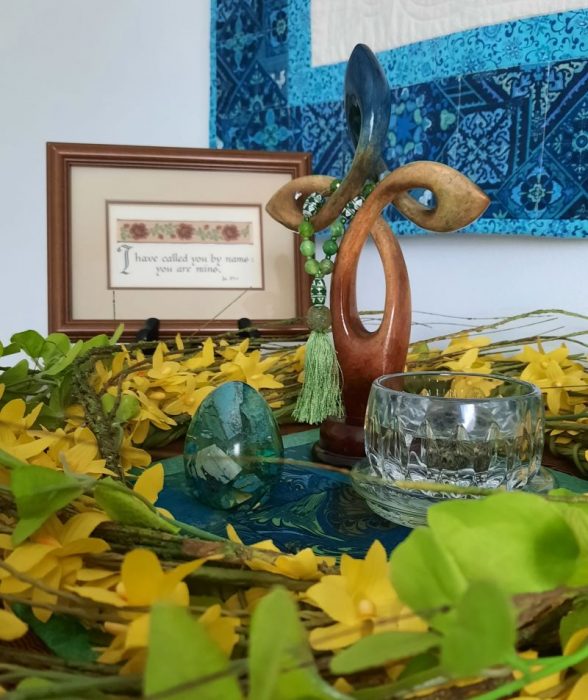
My bowl of water not only reminds me of the water of baptism but also of the water of life. My bowl of water is the font of the Christian Church but also the well of life for all people. It is a solemn reminder to me to visit my own well within, daily, that place where the Holy Spirit is always welling up inside all of us, calling us to drink from the living waters.
As Jesus cried out, “Let everyone who is thirsty come to me, and let the one who believes in me, drink. As the scripture has said, ‘Out of the believer’s heart shall flow rivers of living water.’” (John 7:37,38)
They say that April showers bring May flowers. May is just days away and spring seems to have sprung and shaken off the grip of winter. Blooms and greening finally illustrate the Earth’s season of renewal. The landscape of my wintry heart is continuing to thaw and green.
My passage through this challenging early spring has been guided by God the Creator, by spring’s unique rhythms and by the elements of wind and water. It continues to prepare me to experience God’s promise of meeting the Risen Christ and to embrace my own personal resurrection. Alleluia!
Beneath the tree, purple plum
leaves pool; beauty’s farewell to
a season well spent.
–EHB
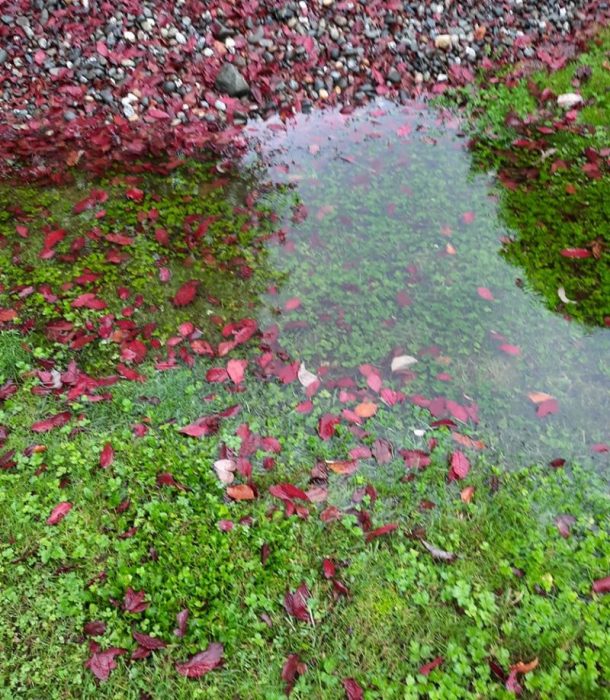
 It’s here! Christine Sine’s new book is now ready for purchase! Journey along with Christine as she walks you through contemplative container gardening. Reviews are coming in:
It’s here! Christine Sine’s new book is now ready for purchase! Journey along with Christine as she walks you through contemplative container gardening. Reviews are coming in:
“Digging Deeper is a beautiful companion for anyone who is looking for a mindful and sacred way of connecting their bodies to their souls, and their prayers to actions. All you need is a bowl, some dirt, this lovely book, and the desire to slow down and dig deep. – Jerusalem Jackson Greer, author of At Home in this Life: Finding Peace at the Crossroads of Unraveled Dreams and Beautiful Surprises”
Editor’s Note: We are delighted to share this excerpt from Rev. Dr. Randy Woodley’s newest book Becoming Rooted: One Hundred Days of Reconnecting With Sacred Earth.
What does it mean to be rooted in the land? How are we shaped by being from somewhere, some place, some land in particular? How do we become rooted?
Indigenous people are those who originate naturally from a certain land, who have dwelled there for a long period of time. To be Indigenous is to be rooted: to be part of a community or ethnic group with historic continuity. Indigenous people understand how to live with the land.
We are all indigenous to some place. We are all from somewhere. I repeat: we are all indigenous, from somewhere. Allow that phrase to sink deep into your being. Now begin to open yourself up to the reality embedded deep within your own DNA, your very own identity. Each human being is a finely crafted amalgamation of various ethnicities, each originating from a particular place on Earth. Your ancestors were, at one time, all indigenous. Might we regain a bit of our ancestors’ indigeneity, much of which has likely been lost through time and travel? Your parents, grandparents, and great-grandparents who lived and breathed and experienced life before you—they are now living through you. From manifold generations back, they looked forward, sometimes even on their deathbeds, to your life. They and their indigeneity matter because you are here now, as their living hope.
Why does indigeneity matter? Because people who have lived on their own land from time immemorial have worked out their relationship with the plants, animals, weather, and mountains. Those relationships grew and matured over time until there were balance and harmony between the people indigenous to that place and the rest of the community of creation. In order to live in harmony and balance on the land, we all need to recover or discover truly Indigenous values.
We are all indigenous to some place. We are all from somewhere. This is not to say we should all claim to be capital-I Indigenous. Most of us have settler ancestors: those who moved onto land not their own and displaced its original inhabitants. Others of us descend from people who did live somewhere in the world, for generations—people who once belonged to the land. We can all become more lowercase-i indigenous on the land. So perhaps we should all be asking the question, Who were we all before we were colonized or modernized or urbanized or westernized? Like most people of nations composed of immigrant peoples, I am a finely crafted mix of various ethnic streams—and so, likely, are you. I was raised near Detroit, Michigan, and I am a Cherokee descendant recognized by the Keetoowah Band of Cherokee. This gives me no special rights or claims; it simply is. I have very little Indian ancestry, and as you will discover in this book, I was not raised much around Native American culture.
Although being Indian was a significant part of my identity growing up, I only began practicing a more traditionally oriented Indigenous lifestyle and way of thinking in my twenties. I have learned, over many years, to think differently than the dominant culture—the more I learned about an Indigenous way of viewing the world, the more natural it felt. I also realized that seeing all life as sacred and spiritual was what I had already learned while growing up: from my parents, grandparents, aunties, and uncles. I discovered that even though most of my family had been assimilated into Western society for generations, they still retained some Indigenous values. Perhaps the same is true for you. Besides my limited Native American DNA, I also carry in my body the ancestry of numerous other nations from several continents. At one time, each of those peoples was indigenous to somewhere. They lived in a particular place, and they understood that distinct land and their place within it very well. Worldviews can be changed. Yes, true indigeneity is something earned over thousands of years. Yet if we try, we can all learn to adopt indigenous values into our lives—both from our own ancestry and, if we are very fortunate, from the Indigenous people who live with the land upon which we now live.
Planting your roots on the land in which you live is the only way to restore harmony and balance on Earth. The alternative is extremely bleak. If we fail to connect with the land in a very real and tangible way, we might still have a good life. But why miss out on the fullest of what life has to offer? Why miss out on learning from the greatest teacher, the Earth herself? Why miss seeing the beauty that awaits us in a renewed and fruitful relationship of mutual caring?
Becoming Rooted contains one hundred short meditations, or observances, to help us all become better Earth relatives. Like relatives, we are connected to one another whether we like it or not. The Earth and the whole community of creation live with us in a reciprocal relationship. What we do to the Earth and her creatures affects us. Without a strong relationship to the land, we will continue to flow with the dominant cultural view, objectifying the Earth and all her creatures: extracting, developing, and polluting without deep remorse. The Earth will not allow us to continue in this way. Even now, we are experiencing the “natural” disasters that could dominate our future.
I am inviting you on a one-hundred-day journey with creation. This journey will take you deeper into your own particular place— your own original somewhere. Becoming Rooted will help you encounter the particular place that makes you someone. The journey will help you get in touch with your own roots: with the land on which you now live and with the people who lived on that land for thousands of years prior to your arrival.
I hope you will allow these daily reflections, as seen through my particular Indigenous experience, to call you back to yours. I invite you not to mimic my experience but to integrate your own experiences, rooted in your sense of self and your own developing indigeneity. The book is for those recently indigenous to this land; Native Americans; and those who are many generations removed from their own indigeneity, which includes all immigrants. We all need to remember—or not forget in the first place—how to live with the Earth.
This journey is your personal invitation into a different kind of relationship with nature—or, as I like to say, with the whole community of creation. It is also an invitation into a different kind of relationship with Creator, however you understand Creator to be present in your own life and within everything—as God, as Great Mystery, as a higher power, or as the universe.
In these pages, I will intermix terms like nature and creation. I will talk about Creator, or Great Mystery, or God. As you read, feel free to substitute your own sense of the force you believe animates the universe. I come out of a Christian experience, so some of my references will be connected to that tradition. Your own spiritual or religious experience may be different from mine, be it Buddhism, Paganism, Daoism, Islam, Sikhism, or no formal religion whatsoever. Having taught world religions in graduate school for over a decade, I know that nearly every sacred tradition has within it an admiration for the natural world. The approach we will be taking on this journey goes deeper than any one religion. Our journey will embrace the commonality of our humanity as our spirituality. We are on this journey together. We all have the Earth in common, no matter where we are from. Everyone in the whole community of creation has common cause to live well together on the Earth and to care for nature. But please make no mistake: nature can be unforgiving. I have noticed that each of us feels a deep and primal longing both to experience nature and to protect ourselves from its harsh realities.
This balance has been the plight of humanity for as long as we have inhabited the Earth. Despite our fear of the natural world, our fascination with the beauty of creation and her creatures—the whole community of creation, of which we are a part—never ceases. On one hand, we wrap ourselves in the most concrete and blacktopped urban world imaginable. We cheer on the most philosophical of claims, the most rigorous of academic theories, and the most mechanistic of contraptions. On the other hand, a simple tree on the horizon, a hummingbird sipping its nectar, a rainbow, or freshly fallen snow still awakens our deepest sense of awe. In the process of protecting ourselves from the harshest realities in nature, we may not realize that most of the world has drifted far from our state of natural wonderment. Deep inside, though, often without realizing it, we miss nature’s beauty and the sense of her inspiration.
Eloheh (pronounced “ay-luh-HAY”) is a Cherokee word meaning “harmony,” “wholeness,” “abundance,” “fullness,” “peace,” and much more. The vision for the nonprofit organization that my wife and I co-sustain came from a sacred and powerful dream I had in 1998. The results of that vision have come, after years of many joys and heartaches along the way. Located on ten acres, in the foothills of the Oregon Coastal Mountain Range, is the place we call home: Eloheh Indigenous Center for Earth Justice and Eloheh Farm & Seeds.
Our goal at Eloheh is to live in harmony with the land by using traditional Indigenous North American knowledge, wisdom, and practices as a guiding model that embodies educating our whole selves. At Eloheh my wife, Edith—who is an Eastern Shoshone tribal member—and I develop, implement, and teach sustainable and regenerative Earth practices. Eloheh Farm is a model of regenerative agriculture, animal husbandry, and wild-tending systems that support human needs while improving the land and all creation inhabiting the web of life here. We regularly hold schools, cohorts, and summits that teach these skills to others. More importantly, we hope to help others love the land on which they live. To accept our place as simple human beings—beings who share a world with every seen and unseen creature in this vast community of creation—is to embrace our deepest spirituality. The journey we will take through these one hundred days will lead us away from the values and priorities of the “American dream”—or what I call an indigenous nightmare—toward a better understanding of what can be called “the harmony way.” The harmony way is a universal set of values that I observed among many Indigenous peoples years prior to my PhD dissertation work, where I investigated the construct in a more in-depth way. The values within a harmony way framework have sustained many of the Indigenous people in the world over millennia. The values of the harmony way are the values that will sustain us well into the future. We are all indigenous to some place. We are all from somewhere. We can all become rooted in the land that sustains us. I invite you on the journey.
We must all get together as a race and render our contribution to mankind.
—Redbird Smith, Keetoowah Cherokee, 1918
For more from Randy Woodley listen to this great podcast interview https://www.circlewood.online/podcastepisodes/episode/4bcc5cdc/becoming-rooted-randy-woodley-on-his-new-book-of-daily-reflections
As an Amazon Associate I receive a small amount for purchases made through appropriate links. Thank you for supporting Godspace in this way.
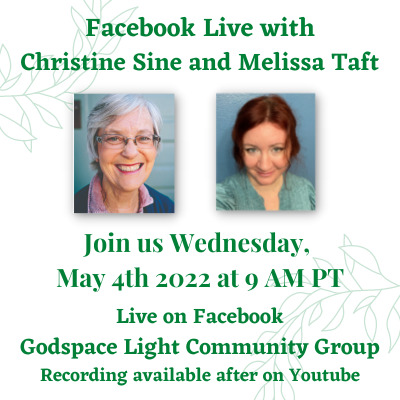 TOMORROW! Wednesday, May 4th at our regular time of 9 am PT, join Christine Sine and Melissa Taft for a discussion on Restoring Rhythms and Seasons. Live on Facebook in the Godspace Light Community Group. Can’t join us live? Catch it later on youtube!
TOMORROW! Wednesday, May 4th at our regular time of 9 am PT, join Christine Sine and Melissa Taft for a discussion on Restoring Rhythms and Seasons. Live on Facebook in the Godspace Light Community Group. Can’t join us live? Catch it later on youtube!
What are the rhythms and rituals that hold your life together? What do you do to sustain them?
You have probably figured out that this is one of my favourite topics to talk about, especially at the moment when there seems to be so much that is destabilizing the rhythm of our lives and the world in which we live. It is also a theme that I continue to grow in my understanding of every year. I first talked about it in my book Godspace and then again in Return to Our Senses, and now I am working on another book that will further express what I have learned.
My growing understanding connects to my increasing rootlessness in the earth and my concern for creation. As I said in my Meditation Monday last week, we all need “symbols and rituals of hope that connect us to the earth and the rhythm of life.” So now we need to explore what those symbols and rituals could look like and how they reinforce our connections between worship and creation.
What makes for resilient spirituality? How do we maintain and grow our faith through the ups and downs of life while growing the roots that go deep into our ever-changing understanding of who God is?
I still draw from my book Godspace, (originally called Sacred Rhythms) and the helpful concept of two types of rituals – those of restoration and of transformation that anthropologist Paul Hiebert wrote about in his book Anthropological Insights for Missionaries.
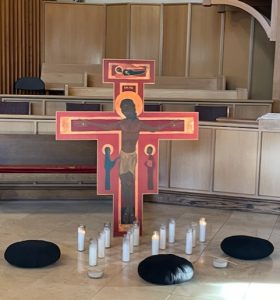
Taize style worship – photo Christine Sine
Rituals of Restoration
These are the practices that reinforce our faith in the beliefs that order our lives and anchor us in the religious communities in which these beliefs are expressed. Restorative practices are highly structured and do not change from day to day or year to year. They reaffirm our sense of order and meaning in the universe, our community & our own lives. Most importantly, they intentionally connect our daily activities to the life, death and resurrection of Christ.
Possibilities include daily prayer, sabbath practices, regular church gathering, taking communion, following the liturgical calendar and the use of liturgical symbols like the sign of the cross, candles, and incense. I even find that writing my weekly blog post can be a stabilizing and restorative ritual. Creation-based rituals are the main place in which these have changed for me. In the last couple of years, I added creation-based rituals and rhythms to these; working and walking in the garden – and my awe and wonder walks around the neighborhood – are tremendously powerful restorative practices.
Generally speaking, it is the creation of rhythms rather than the actual practices that are important. The practices may change but I love to have a regular rhythm to the day, week and year. In fact the breaking of this rhythm is one thing I find destabilizing. Praying each day is an essential part of my faith practice but what those prayers look like can change from day to day and week to week.
What are the restorative rituals that anchor your beliefs and reinforce connections between creation and your faith?
Rituals of Transformation
These are characterized by a high degree of creativity with little repetitive structure. Their goal is to upend the established way of doing things and restore a measure of flexibility and personal intimacy. They stop our restorative practices from becoming boring and our faith from becoming stagnant. They encourage our faith to grow and change, enabling us to adapt to the passages of life and changes in our culture. In the liturgical calendar, Advent & Lent were specifically designed with this intention. Prayer retreats, conferences and workshops can also accomplish this – though these days it seems that such events are more geared towards reinforcing the status quo than changing it. Pilgrimage, Biblically and culturally based celebrations like Easter and Earth Day can also accomplish this. Prayer walks, and even walking the labyrinth are all practices that maintain this type of flexibility.
When I was on the Mercy Ship Anastasis, and the ship was ready to sail to a new port, we held what was called a moving of the ark ceremony, harkening back to the fact that the Israelites would only break camp and move when the cloud over the ark of the covenant moved. We celebrated with a special worship service, sharing the good things that had happened in the port we were leaving, sharing communion and then learning a little about the new port we were heading towards as a time of preparation.
I don’t live on a ship that moves every few weeks anymore but I know the importance of marking milestones in my life journey in similar ways. Acknowledging transitions, looking back with gratitude and forward with anticipation is a wonderful, faith-building exercise that all of us should practice on a regular basis.
What are the practices that provide both stability and flexibility in your spiritual life? What are transformative habits that shape your faith?
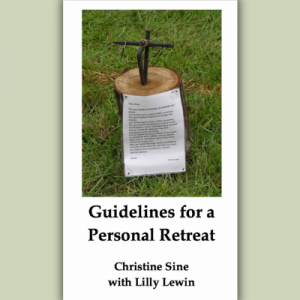 No matter the time of year, it’s important to pause and take time to reset and restore. An excellent way to do that? Take a personal retreat. Building a retreat into the rhythm of your life is a spiritual practice often lost in our helter-skelter, busyness-is-next-to-godliness world. This booklet is based on the most popular posts about spiritual retreats published on Godspacelight.com over the last few years and provides resources for taking a spiritual retreat either on your own or with a friend or spouse. Check it out in our shop!
No matter the time of year, it’s important to pause and take time to reset and restore. An excellent way to do that? Take a personal retreat. Building a retreat into the rhythm of your life is a spiritual practice often lost in our helter-skelter, busyness-is-next-to-godliness world. This booklet is based on the most popular posts about spiritual retreats published on Godspacelight.com over the last few years and provides resources for taking a spiritual retreat either on your own or with a friend or spouse. Check it out in our shop!
As an Amazon Associate, I receive a small amount for purchases made through appropriate links.
Thank you for supporting Godspace in this way.
When referencing or quoting Godspace Light, please be sure to include the Author (Christine Sine unless otherwise noted), the Title of the article or resource, the Source link where appropriate, and ©Godspacelight.com. Thank you!

